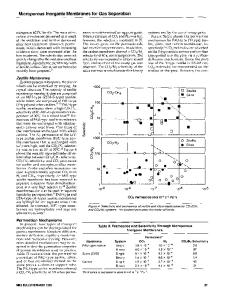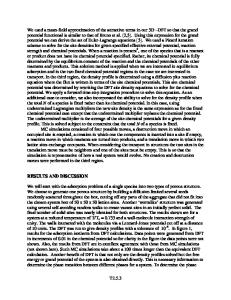Microporous Materials for Separation Membranes
- PDF / 341,336 Bytes
- 2 Pages / 595.276 x 790.866 pts Page_size
- 84 Downloads / 358 Views
BOOK REVIEW
Microporous Materials for Separation Membranes Xiaoqin Zou, Guangshan Zhu, First published: 24 May 2019 Print ISBN: 9783527343973 |Online ISBN:9783527343997 |DOI: 10.1002/9783527343997, © 2019 Wiley‐VCH Verlag GmbH & Co.
© Springer-Verlag GmbH Germany, part of Springer Nature 2020
The saying “You should not judge a book by its title is very much the case with this excellent book; the title gives you no indication into its true nature. It offers an in-depth guide to both microporous materials including microporous silica, porous carbons, zeolites, metal–organic frameworks (MOFs), and porous organic frameworks (POFs). The authors discuss these materials in relationship to them being used as or in membranes for hydrogen recovery, carbon dioxide capture, air purification, hydrocarbon separation, pervaporation, and water treatment. The book is authored by two people Xiaoqin Zou and Guangshan Zhu to give it a standard style with no repeats of work or chapters that you tend to get with multiple authored books. Chapter 1 gives maybe one of the best introductions of microporous materials I have ever read. In fact, I think this could be a stand-alone short manuscript on its own as it would be exceptionally useful for anyone starting work on
microporous materials. The chapter covers the chemistries of microporous materials and membrane separation and the basics of membrane fabrications and module configurations. Chapter 2 starts to go into the detail of using silica with micropores that make it suitable for membrane separation of small molecules such as light gases, water, and small organics. Chapter 3 covers broad topics in porous carbon synthesis and membrane modification. The regular-porestructure of carbon nanotubes and graphene are described exceptionally well as are the discussions on mixed matrix membranes. Chapter 4 is a more traditional chapter dealing with zeolites and molecular sieves as traditional crystalline porous material with identified pore structures. This chapter leads into a discussion on mixed matrix membranes started in Chapter 3 but it provides a real in-depth study on some amazing materials. Chapters 6, 7, and 8 are devoted to fully discuss zeolites. Chapter 6 describes the chemistry of zeolite membranes encompassing crystal growth, microstructures of film layers, and membrane characterisation. Chapter 7 deals with zeolite membranes for gas separations. Chapter 8 looks at the more industrial side of pervaporation using membrane separation techniques and details are given as to its importance in the chemical and petrochemical industries. Chapter 9 moves into newer work on Metal–organic frameworks (MOFs). Again, a very good introduction is given into these materials and their use and possible uses are discussed. This chapter also provides an excellent review on MOFs and their applications that are an extensive class of crystalline materials with structural diversity and tuneable porosity. Chapter 10 takes an in-depth view of using MOFs for carbon dioxide capture. This chapter includes som
Data Loading...











